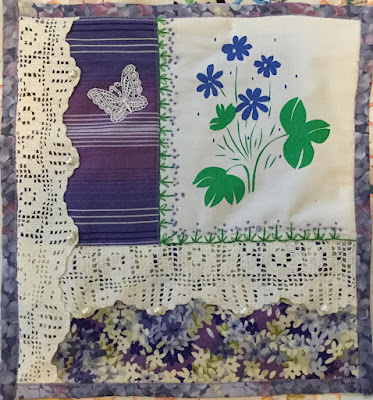It was a huge surprise to find that my stories of growing up in Tonawanda, NY were such a hit, drawing hundreds, and sometimes a thousand, readers to my blog. It all started when a post I created to celebrate my Aunt Alice Ennis's birthday 'went viral' weeks after it was posted. I snooped around and found a photo from that post had been shared on a Facebook group "Growing Up in the Town of Tonawanda."
I joined the group and shared some older blog posts I had written about Tonawanda history, which also had a wonderful reception.
My dad wrote a memoir of his childhood and I decided to share it with the Facebook group, and soon new friends were encouraging me with "more, please" comments. In the past few months I have added my own memories.
I have enjoyed reading about other's lives since a child, and still enjoy reading diaries and memoirs and autobiographies. But it amazes and humbles me to hear that people have relived and recalled their own experience through my sharing family stories and photos.
In January I will continue the family saga as our family moved to Detroit in 1963, sharing about my homesickness and Dad's new life. It won't be a Tonawanda Tale but the story of Tonawanda folk adjusting to a new community.
I have been amazed how many Tonawanda folk I have meet over my lifetime. In Philadelphia or Michigan I have discovered so many folk with Tonawanda roots, and my brother has as well. The Tonawanda settlers crossed New York State by land or the Erie Canal, and many continued west across Lake Erie into Canada or Ohio or Michigan. And of course work and career take many of us to places we never dreamt we'd go to.
Some, like my cousin David, have returned to Tonawanda from careers elsewhere. After all, there is no place like home, and home is where our family is.
Have a wonderful holiday season and may your hometown memories be warm and bright.
Stories by Me
The John Kuhn Family: https://theliteratequilter.blogspot.com/2016/07/the-kuhn-family-of-tonawanda-ny.html
The Sheridan Park Volunteer Firemen: https://theliteratequilter.blogspot.com/2016/07/dads-memories-of-sheridan-park.html
The Becker Family: https://theliteratequilter.blogspot.com/2016/11/eugene-gochenour-memoirs-becker-family.html
Happy Birthday, Aunt Alice: https://theliteratequilter.blogspot.com/2016/01/happy-birthday-aunt-alice.html
Halloween Costumes: https://theliteratequilter.blogspot.com/2016/10/halloween-costumes-of-1950s.html
Christmas Past (late 1950s): https://theliteratequilter.blogspot.com/2015/12/christmases-past-1956-and-1957-photos.html
Building and running a 1940s gas station: https://theliteratequilter.blogspot.com/2015/07/the-station-building-and-running-1940s.html
Tom's Brook Massacre: https://theliteratequilter.blogspot.com/2014/04/the-rhodes-family-massacre-at-toms-brook.html
 |
Emma and Al Gochenour
with Mary and Gene |
 |
Al and Emma Gochenour with
daughters Alice and Mary |
Dad's Memoirs
Part I: https://theliteratequilter.blogspot.com/2016/07/memoirs-of-eugene-gochenour-part-i.html
Part II: https://theliteratequilter.blogspot.com/2016/08/memoirs-of-eugene-gochenour-part-ii.html
Part III: https://theliteratequilter.blogspot.com/2016/08/eugene-gochenour-memoirs-part-iii.html
Partk IV: https://theliteratequilter.blogspot.com/2016/08/eugene-gochenours-memoirs-part-4.html
Scouting: https://theliteratequilter.blogspot.com/2016/09/memories-of-eugene-gochenour-scouting.html
Alger Gochenour: https://theliteratequilter.blogspot.com/2016/11/alger-jordan-gochenour-today-i-share-my.html
Grease and Cars: https://theliteratequilter.blogspot.com/2016/09/eugene-gochenours-memoirs-grease-and.html
Boating Tales: https://theliteratequilter.blogspot.com/2016/10/eugene-gochenours-memoir-boating-tales.html
Floods and Subs: https://theliteratequilter.blogspot.com/2016/10/eugene-gochenours-memoirs-floods-and.html
Lives Cut Short: https://theliteratequilter.blogspot.com/2016/10/eugene-gochenours-memoirs-live-cut-short.html
New York State Theme Parks: https://theliteratequilter.blogspot.com/2016/10/eugene-gochenours-memoirs-new-york.html
Runnning a Coffee Truck: https://theliteratequilter.blogspot.com/2016/10/eugene-gochenours-memoirs-running.html
Pets, Fishing, and Hunting: https://theliteratequilter.blogspot.com/2016/09/eugene-gochenors-memoirs-pets-fishing_10.html
Gene Gets a Girlfriend: https://theliteratequilter.blogspot.com/2016/09/eugene-gochenours-memoirs-gene-gets.html?google_comment_id=z125uvtafzbywjdbi04cfbky4suhz5gyx3w
 |
| Aunt Alice and me |
My memories
My Old House: https://theliteratequilter.blogspot.com/2016/12/my-old-house.html
Birth and preschool: https://theliteratequilter.blogspot.com/2016/11/my-memories-of-growing-up-in-tonawanda.html
Stories my Mother Told Me: https://theliteratequilter.blogspot.com/2016/12/stories-my-mother-told-me-and-other.html
Trash Picking: https://theliteratequilter.blogspot.com/2013/10/trash-picking.html
Lois Gibbs on my Green Heros Quilt: https://theliteratequilter.blogspot.com/2012/11/my-green-heroes-quilt-lois-gibbs.html
Songs My Mother Sang Me: https://theliteratequilter.blogspot.com/2014/04/songs-my-mother-sang-me-1940s-novelty.html
Houses: https://theliteratequilter.blogspot.com/2014/05/houses.html
Related Books Reviews
Love Canal: https://theliteratequilter.blogspot.com/2016/05/the-history-and-legacy-of-love-canal.html
1901 Pan American Exposition book: https://theliteratequilter.blogspot.com/2016/10/spectacle-and-assassination-at-1901.html
The Sky Unwashed: https://theliteratequilter.blogspot.com/2013/09/mother-russia-and-sky-unwashed-by-irene.html








































